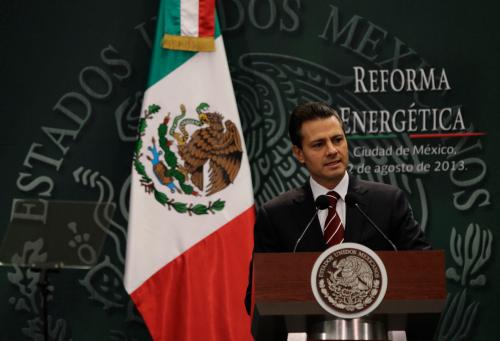This paper is sixth in a series from the Cross-Brookings Initiative on Energy and Climate. The paper’s executive summary follows, and you can view the full series here.
Executive summary
The 40 percent decline in U.S. coal-fired power generation over the last decade accounted for 75 percent of the total reduction of 800 million metric tons in U.S. energy-related carbon dioxide (CO2) emissions between 2005 and 2017.1 The shift away from coal was mainly driven by lower natural gas prices due to the shale revolution and stagnant U.S. electricity demand, and to a lesser extent by policy-supported growth in wind and solar generation. With power generation accounting for over 90 percent of U.S. coal use, there was a comparable reduction in U.S. coal production over the last decade.
The shift away from coal was mainly driven by lower natural gas prices due to the shale revolution and stagnant U.S. electricity demand, and to a lesser extent by policy-supported growth in wind and solar generation.
Coal production and use in the United States has fluctuated over the past 100 years, with declines following peaks in 1920 and 1945 subsequently being reversed. However, current market and policy factors suggest that another significant recovery is not likely. Future prospects for the U.S. coal industry remain closely tied to its role in electricity generation, where forecasts suggest challenges to coal-fired plants, including competition from abundant and low-priced natural gas, additions of wind, solar, and gas-fired capacity, and stagnant electricity sales. New coal plants are much more expensive to build than either natural gas or renewable capacity, and also face the same dispatch competition as existing coal plants, making it highly unlikely that potential investors could ever recover their costs or earn a return on investment.2
Turning to the role of government policies, it is important to distinguish developments that are largely symbolic from those that could significantly affect coal use. For example, the Trump administration is planning to replace the Clean Power Plan for existing fossil fuel plants that was issued in 2015 and was subsequently stayed by the Supreme Court. Changes to the rule might slow, but would not reverse, the decline in coal-fired generation. However, they could make future coal generation more responsive to any sharp rise in natural gas prices, posing a conundrum for those who support emissions reductions, but also oppose shale gas development and the buildout of gas pipeline infrastructure.
Looking beyond the Clean Power Plan, several recent changes to federal policy, including lifting a coal-leasing moratorium, ending a review of royalty rates, and provision of expanded tax credits for carbon capture and sequestration (CCS), are unlikely to improve coal’s competitiveness as a fuel for domestic electricity generation. A Trump administration proposal to require wholesale electricity market operators to enable full recovery of investment costs and a guaranteed return on equity to economically uncompetitive coal plant operators might have increased coal-fired generation, but it was unanimously rejected by the Federal Energy Regulatory Commission (FERC) in early 2018. As of November 2018, the administration is considering use of the Federal Power Act and the Defense Production Act (DPA) provisions to mandate retention of coal-fired units and purchases of coal-fired power. It is facing significant opposition as it seeks to apply these authorities, which were not designed or intended to achieve such purposes.
States, acting alone or jointly with the federal government, play a key role in shaping the market for coal-fired generation through mandates for increased renewable generation, subsidies for generation at existing nuclear plants facing economic challenges, and energy efficiency programs that reduce electricity demand. For the most part, state-level energy policies have not experienced the significant swings that have occurred at the federal level with new presidencies in recent years.
U.S. coal-fired generators also face significant downside risk from the possibility of future policy changes toward more aggressive greenhouse gas (GHG) mitigation. Truly deep decarbonization would ultimately require emissions reductions across all sectors. However, further displacement of coal-fired generation, which, despite recent declines, still accounted for 23 percent of total U.S. energy-related CO2 emissions in 2017, compares very favorably in both cost effectiveness (cost per ton) and scale of impact over the next 15-20 years to other emission reduction strategies currently under review, such as higher fuel economy standards for light-duty vehicles.
U.S. coal-fired generators also face significant downside risk from the possibility of future policy changes toward more aggressive greenhouse gas (GHG) mitigation. Truly deep decarbonization would ultimately require emissions reductions across all sectors.
On coal exports, overseas sales by U.S. producers increased substantially in 2017, but they are still below levels realized during the 2011-14 period.3 Demand for U.S.-sourced coal tends to be episodic, driven by price spikes caused by natural or policy events that disrupt production in China, Australia, and Indonesia. Projected global demand for metallurgical coal (met coal), which dominates overall U.S. coal exports, is flat to slightly declining.4 This outlook reflects both a slowdown in global steel production growth and changes in steelmaking techniques that are likely to reduce the amount of metallurgical coal used per ton of steel produced. Europe, the largest market for U.S. met coal exports, is expected to have weaker demand than Asia, where Australia, the world’s dominant met coal exporter, benefits from close proximity to the market. The focus of current mine development projects on high-quality, low-cost resources outside the United States suggests that U.S. producers will continue in their current role as peak rather than baseload sources of met coal.
Steam coal producers also face challenges in export markets. The United States currently accounts for less than 2 percent of total global steam coal exports, having experienced a steady decline in its global export market share over the past two decades.5 Europe’s strong commitment to greenhouse gas reduction poses a major risk to sustaining, let alone increasing, sales to the largest historical U.S. steam coal importer. Rapid growth in sales to Asia, where U.S. producers face significant logistical disadvantages relative to other suppliers, is made even more challenging by the increasing efficiency of new coal-fired generators in the region that keep coal consumption growth below the rate of generation growth.
The bottom line is that U.S. coal production is unlikely to again rise from the ashes. This outlook reflects the combined effects of stagnant domestic electricity demand growth, advances in competing generation technologies offering low or no fuel costs and attractive capital costs, the risk of future emissions mitigation as a threat to existing coal-fired generation and new investment in coal and other emissions-intensive technologies, and unfavorable export market conditions.
-
Footnotes
- U.S. Energy Information Administration, “Monthly Energy Review,” (Washington, DC: United States Department of Energy, August 2018), Tables 12.1 and 12.6, https://www.eia.gov/totalenergy/data/monthly/pdf/mer.pdf.
- U.S. Energy Information Administration, “Electricity Market Module,” (Washington, DC: United States Department of Energy, April 2018), https://www.eia.gov/outlooks/aeo/assumptions/pdf/electricity.pdf.
- See Table 1. Coal export volume equals coal production times coal export share.
- International Energy Agency, “Coal 2017,” (Paris, France: December 18, 2017), https://www.iea.org/publications/freepublications/publication/CoalInformation2017Overview.pdf; Accenture, “Steel Demand beyond 2030: Forecast Scenarios Presented to OECD,” (Paris, France: Accenture, September 28, 2017), https://www.oecd.org/industry/ind/Item_4b_Accenture_Timothy_van_Audenaerde.pdf.
- International Energy Agency, “Coal 2017.”
The Brookings Institution is committed to quality, independence, and impact.
We are supported by a diverse array of funders. In line with our values and policies, each Brookings publication represents the sole views of its author(s).






